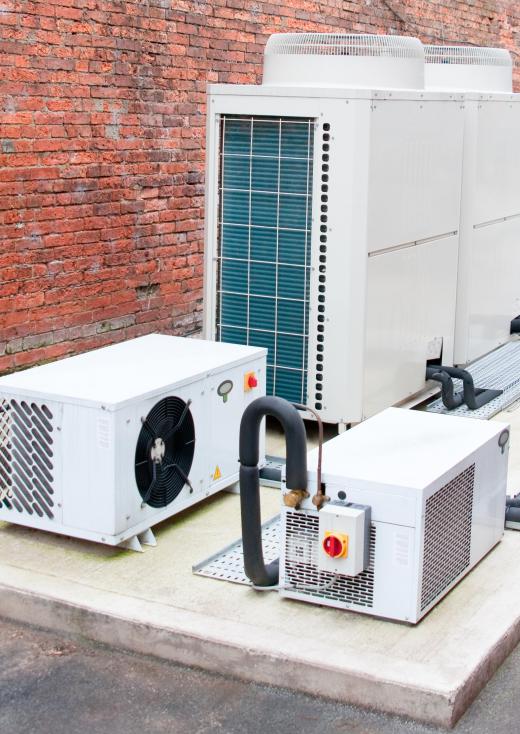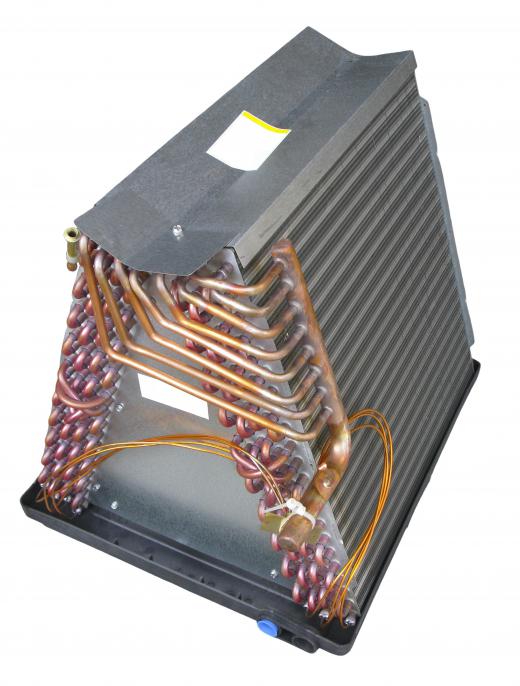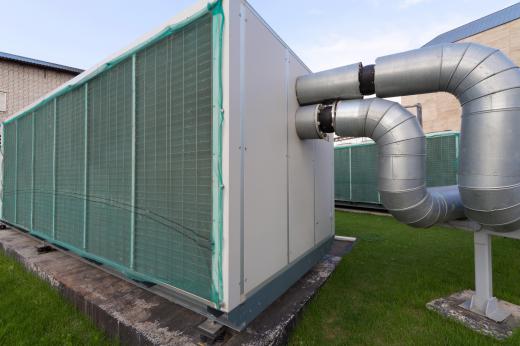Cooling capacity is a measurement of the rate at which heat is removed from an interior space, usually in the context of air conditioning. In most cases this sort of capacity is stated as an average; it’s how a certain machine or system will work under standard conditions. These conditions take into account such factors as the volume of the space being cooled and the air temperatures both inside and outside the space, but assume ordinary environments and industry-standard insulation. If a unit is being used unconventionally or in more extreme circumstances, the stated capacity might not prove accurate. In most cases the capacities of modern air conditioners are printed on the outside of the unit or otherwise conspicuously displayed, and can be useful to consumers deciding between competing options.
Air Cooling Basics

Internal environments often retain heat more readily than the outside, particularly in the warmer summer months. The same insulation that keeps heat trapped in the winter can do the same in the summer, which can cause houses, rooms, and offices to become sweltering and sticky. Fans and open windows can bring some relief, but industrial air conditioners and cooling units are often the most effective.

There are usually a number of different options, from built-in systems to portable window units. Similarly, some are designed for smaller spaces, like single rooms or small apartments, whereas others can heat entire homes or even buildings. A lot depends on their size and capacity. How they operate is usually pretty much the same no matter the specifications, though, and the capacity to cool is more a matter of internal mechanics than outside specifications. Air conditioners of all varieties typically cool a heated room by transferring the heat to the fluid-filled evaporator coils of the unit. The units condense some of the moisture in the air, too. That makes the atmosphere in the room not only cooler, but also less humid and more comfortable.
How Capacity Is Measured

It’s generally the case that cooling capacities are rated in British Thermal Units (BTUs) per hour, though sometimes the measurement is also expressed in tons. A ton of cooling capacity is the same as 12,000 BTUs per hour, and the term has its origin in the cooling effect of a ton of ice. Often, capacity measurements are given in tonnage for cooling units and BTUs for heating units. Broken down, a BTU is based on the amount of energy it takes to raise the temperature of a pound of water by just one degree Fahrenheit.
Ratings and Space Specifications
A machine’s capacity to cool a space is directly related to the size of that space. As an illustration, a 2,000-square-foot home built to standard specifications in a more or less moderate climate will usually require an air conditioning system with a capacity of about 48,000 BTUs per hour. In contrast, an average 150-square-foot bedroom in a similarly-situated home will probably be able to get the same results with a unit rated at just 5,000 BTUs per hour.
Cooling capacities are usually printed directly on the sales sticker of newer air conditioning units. On older models, the capacity is sometimes coded within the serial numbers. In most cases these ratings apply not only to residential and commercial air conditioning systems, including heat pumps that operate in the air conditioning mode, but also to industrial chillers, cooling towers, and other cooling equipment. These sorts of machines are necessarily more intense and as such often have higher capacities.
Energy Efficiency
In many parts of the world, energy efficiency has become something of a serious concern in recent years. Appliances that consume a lot of electricity and other resources are often thought to be a drain on the environment and its resources. Air conditioning units are often some of the biggest consumers, particularly when they’re being used constantly; this makes an accurate and efficient capacities especially important.
Many manufacturers have adopted efficient practices and promise that their machines will use energy as responsibly as possible, and there are also a number of independent groups that can certify and audit these claims. The Air-Conditioning, Heating and Refrigeration Institute (AHRI), for instance, independently certifies heating, ventilating, air conditioning, and refrigeration (HVACR) equipment and components to ensure these systems meet industry efficiency standards. Generally, the Institute — known as the Air-Conditioning and Refrigeration Institute (ARI) prior to 2009 — works with manufacturers to develop standards and guidelines that result in uniform ratings, including capacity ratings, to give consumers a basis of comparison. An ARI number on a heating or air conditioning unit is a guarantee that its cooling or heating capacity has been properly tested.
